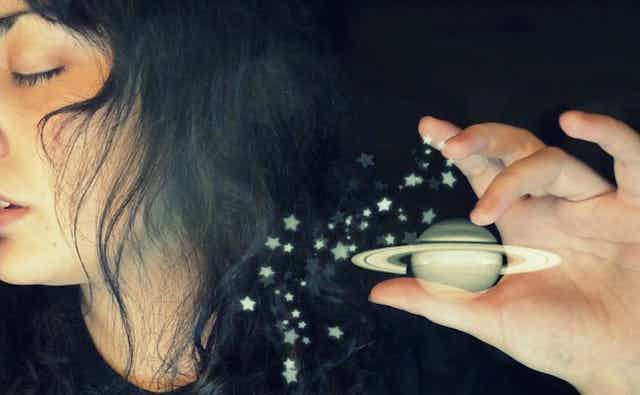Everyone’s favourite ringed planet – the magnificent Saturn – is well worth some extra attention in the coming days. Tomorrow night, it reaches opposition, shining at its very best and brightest, directly opposite the sun in the sky.
A few nights later, on the evening of Wednesday May 14, most Australians will see Saturn blink out as it disappears behind Earth’s full moon, an event known as an “occultation”.
Saturn has been moving from being a morning object to an evening one over the past few months. On Saturday night, it will reach opposition, which means that Saturn will be directly opposite the sun in the sky. (The exact moment of opposition occurs at 4:29am AEST Sunday, as defined by Saturn having an apparent longitude that differs from that of the sun by 180 degrees.)

As the sun sets towards the west, Saturn can be found rising towards the east. Not only will Saturn be visible for the whole night, but it will also be at its brightest, because opposition marks the point of closest approach between the planet and the Earth.
It’s a matter of geometry that occurs because both Earth and Saturn are orbiting the sun. At opposition, the two planets must be on the same side of the sun. This brings them closest together, as the Earth passes between Saturn and the sun.
But not all oppositions are equal. Both the Earth and Saturn orbit the sun on eccentric orbits, which means their distances from the sun vary over time.

This opposition falls quite close to Saturn’s aphelion (furthest point from the sun) so as oppositions go, this is one of the more distant for the ringed planet. On Wednesday, the two planets will be approximately 1,340 million kilometres apart (roughly nine times further than Earth is from the sun!).
An opposition of Saturn occurs every year (every 378 days, or so), but for the first time this century, this week will also allow us to see an occultation of Saturn by the moon in the evening sky.
During the early evening of Wednesday May 14, across most of Australia, the moon will pass directly in front of Saturn. The planet will be hidden from view for just on an hour. Some northern regions, such as Darwin, will see a grazing occultation, in which Saturn touches the moon but doesn’t quite disappear. In north Queensland, the moon will slide past very close to Saturn but not block any light from the planet.


This occultation is particularly special in that it coincides with the full moon. In other words, it occurs while both the moon and Saturn are at opposition!
So it won’t be hard to find, simply look for the moon in the eastern sky. You might also make out the constellation of Scorpius, the curving shape of stars to the right of the moon.
The occultation can be seen with the naked eye, but Saturn is always a favourite object to view through a telescope. If you get the chance, a telescope will show the planet and also its rings disappearing behind the moon.
You might even see Saturn’s largest satellite, the behemoth Titan, shining next to the planet, in the same plane as the planet’s rings. It will disappear behind the moon ahead of Saturn. For a real challenge, three of Saturn’s smaller moons, Tethys, Dione and Rhea, should also be visible much closer to Saturn.
For Australia, this is the second of three occultations of Saturn to be seen this year. The first was in February, but occurred during daylight hours, and so binoculars or telescopes were required to observe it.
The third and final occultation will occur on August 4. This will be another evening occultation, and this time the northern part of Australia will see the full event. Unfortunately Tasmania will miss out, with Saturn passing very close to the moon.
People south of Perth will get an extra bonus on June 11, when Saturn will graze the moon at 4:13am (AWST).

It’s Saturn season
Typical of all the planets, occultations of Saturn come in batches or “seasons”.
For Saturn a dozen or more will occur over a 12-month period, then none at all for four to five years.
This is the result of the fact that the moon’s orbit around the Earth is tilted to the orbit of the Earth around the sun – and so most of the time, the moon will pass above or below Saturn in the sky, and no occultation will occur.
It is only when Saturn lies near the point that the moon’s orbit crosses the “plane of the ecliptic” that occultations can happen – and then they occur every time the moon swings by, until Saturn moves away from the crossing point.
Occultations and the unexpected …
It isn’t just the moon that can occult background objects. Of particular interest to scientists are occultations of relatively bright stars by solar system objects.
It was an occultation of a star by the planet Uranus in 1977 which resulted in the discovery of that planet’s ring system – only the second to be discovered. The flickering of a star’s light as rings passed in front of it was again used recently to discover the first rings around an asteroid, the Centaur (10199) Chariklo, located out beyond Saturn.
It is highly unlikely that the forthcoming occultation of Saturn will yield such exciting and unexpected discoveries, but it will be a beautiful spectacle to observe – and will give amateur astronomers across Australia a field day.
It would be well worth keeping an eye on Astronomy Picture of the Day and spaceweather.com in the days that follow the occultation, as there are bound to be a plethora of stunning images taken on Wednesday evening!

